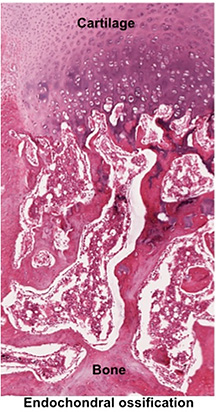|
 Cartilage and bone, both
specialized types of connective tissue, are closely related in
structure and function. In fact, most of the bone in the body
develops from a type of cartilage during the process of endochondral
ossification, as seen in the image at the right. Like other types of
connective tissue, cartilage and bone are composed of cells, fibers,
and ground substance, but the relative rigidity of their
extracellular matrices makes them unique. Cartilage and bone, both
specialized types of connective tissue, are closely related in
structure and function. In fact, most of the bone in the body
develops from a type of cartilage during the process of endochondral
ossification, as seen in the image at the right. Like other types of
connective tissue, cartilage and bone are composed of cells, fibers,
and ground substance, but the relative rigidity of their
extracellular matrices makes them unique.
Despite the similarities between
cartilage and bone, the properties of the cartilage matrix,
including its hardness, density, and avascularity, are distinct from
those of bone. Bone also has a more extensive set of cell types,
possesses extracellular specializations for calcification, and is
well vascularized. These characteristics underlie the greater
capacity of bone for growth, remodeling, and repair. Cartilage and
bone are closely associated in joints, where they work together to
allow movement and/or cushioning of adjacent bones.
The learning objectives for this unit
are:
- Identify the three types of
cartilage (hyaline, fibrous, and elastic) and their histological
features.
- Identify the cells and
structural features within bone.
- Identify the structural features
associated with endochondral bone development.
- Identify the layers and
components of synovial joints and intervertebral discs.
Let's take a look at some tissues. |